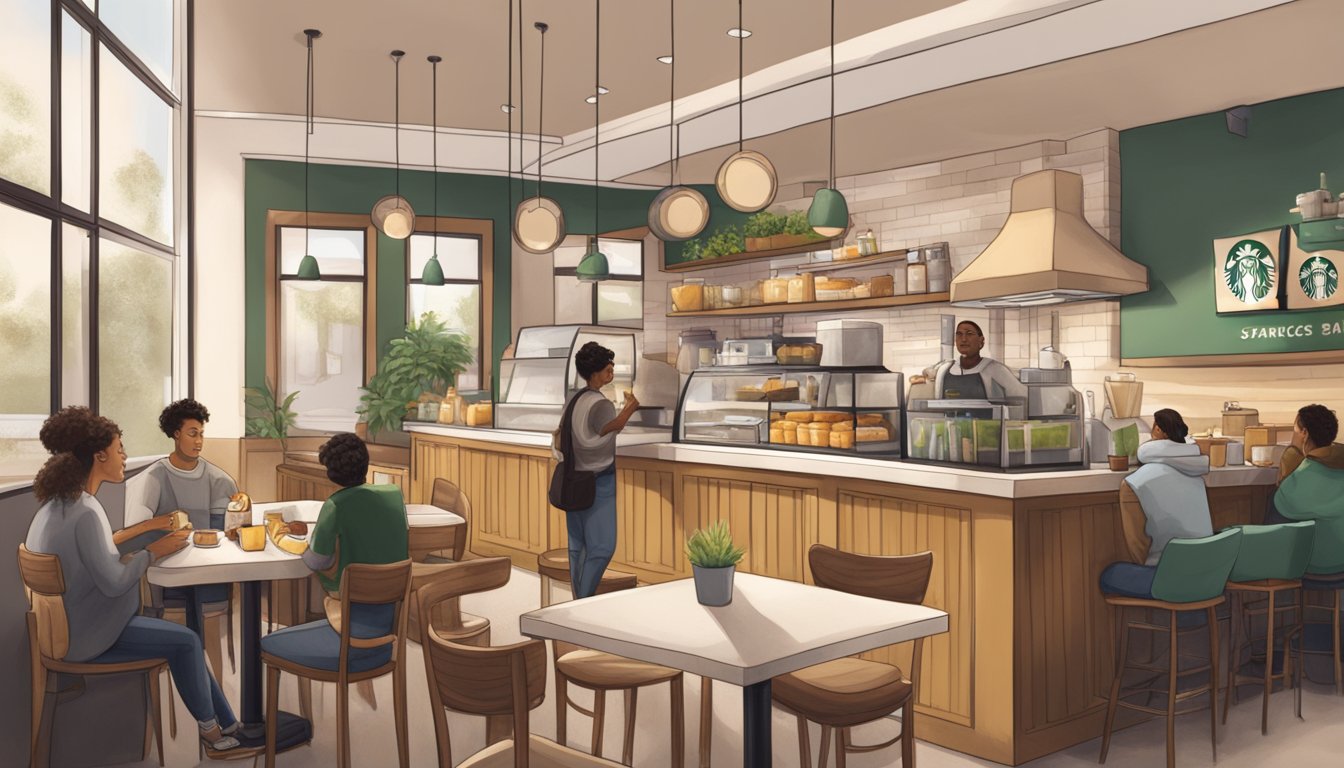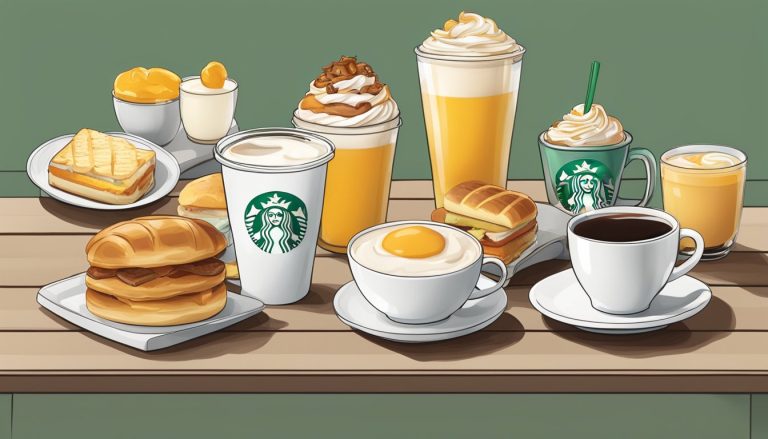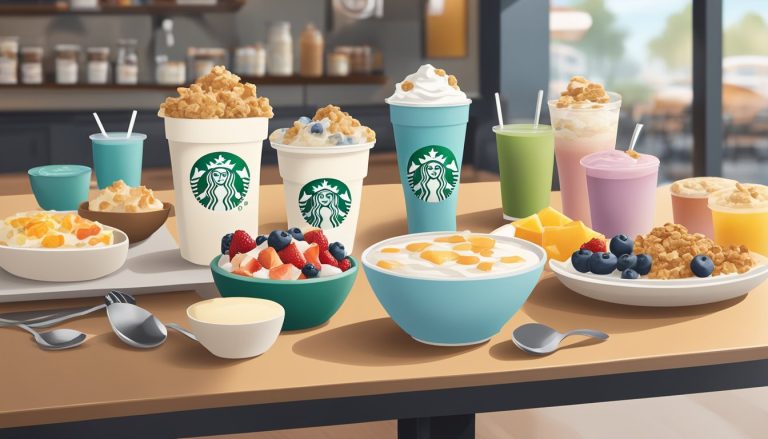Starbucks revolutionized the coffee shop experience by embracing the concept of the “third place” – a social space distinct from home and work. This idea, popularized by sociologist Ray Oldenburg, found its perfect embodiment in Starbucks’ cozy atmosphere, free Wi-Fi, and diverse menu offerings. Starbucks’ breakfast options play a crucial role in solidifying its status as a third place, providing customers with a reason to start their day in a welcoming, community-oriented environment.
The third place concept has been integral to Starbucks’ success since the 1990s. By offering more than just coffee, Starbucks created a space where people could gather, work, or simply relax. The addition of breakfast items to their menu further enhanced this experience, giving customers another reason to choose Starbucks as their morning destination.
As society evolves, so does the notion of the third place. Starbucks has adapted by investing in mobile ordering systems and new equipment to streamline service. This shift reflects changing customer needs while maintaining the core idea of a comfortable space between home and work. Starbucks continues to balance efficiency with the community-building aspect that made it a cultural icon.
The Evolving Concept of the ‘Third Place’
The ‘third place’ has transformed from a sociological concept to a cornerstone of Starbucks’ brand identity. This shift has significantly influenced consumer behavior and expectations in the food service industry.
Origins and Sociologist Ray Oldenburg
Ray Oldenburg introduced the concept of the ‘third place’ in 1989. He defined it as a social environment separate from home and work. These spaces foster community, conversation, and civic engagement.
Oldenburg identified key characteristics of third places:
- Neutral ground
- Leveling social differences
- Conversation as the main activity
- Accessibility
- Regular patrons
- Low profile
- Playful atmosphere
Third places historically included cafes, pubs, and community centers. They played crucial roles in social cohesion and democracy.
Starbucks and the ‘Third Place’ Philosophy
Starbucks adopted the ‘third place’ concept as a core business strategy in the 1990s. The company aimed to create welcoming spaces beyond mere coffee shops.
Starbucks implemented this philosophy through:
- Comfortable seating arrangements
- Free Wi-Fi
- Ambient music
- Personalized service
This approach differentiated Starbucks from competitors. It transformed coffee consumption into a social experience. The strategy proved highly successful, driving rapid expansion and customer loyalty.
Impact of the Third Place on Consumer Behavior
The ‘third place’ concept has significantly influenced consumer expectations. Customers now seek more than just products; they desire experiences and social connections.
This shift has led to:
- Increased dwell time in cafes
- Higher demand for comfortable seating and amenities
- Growth of remote work in coffee shops
- Emphasis on store design and atmosphere
Brands across various industries have adopted similar strategies. They aim to create immersive environments that encourage social interaction and brand loyalty.
The rise of digital technology has challenged traditional notions of the ‘third place’. Starbucks has adapted by integrating mobile ordering and enhancing its physical spaces to maintain relevance in changing times.
Starbucks’ Breakfast Offerings

Starbucks has expanded its breakfast menu to meet evolving consumer preferences and maintain its position as a morning destination. The company’s focus on innovation and quality ingredients aims to enhance the overall Starbucks experience for breakfast customers.
Introduction to Starbucks’ Breakfast Menu
Starbucks offers a diverse range of breakfast items to complement its coffee offerings. The menu includes classic options like oatmeal, breakfast sandwiches, and pastries. Egg bites, introduced in 2017, quickly became a popular protein-packed option. Starbucks also caters to health-conscious customers with items like fruit and nut bars.
The breakfast menu varies by location and season. Some stores feature regional specialties or limited-time offerings. Starbucks regularly updates its menu to keep customers engaged and coming back for new flavors.
Expanding Consumer Preferences for Breakfast
Consumer tastes have shifted towards more nutritious and convenient breakfast options. Starbucks has responded by introducing items like Sous Vide Egg Bites and Protein Boxes. These products cater to customers seeking high-protein, low-carb choices.
Plant-based options have gained popularity. Starbucks now offers alternatives like almond milk yogurt parfaits and vegetarian breakfast sandwiches. The company also provides customization options, allowing customers to modify their orders to suit dietary needs or preferences.
Innovation in Breakfast Items
Starbucks continually innovates its breakfast menu to stay competitive. The company invests in research and development to create unique offerings. Examples include the Double-Smoked Bacon, Cheddar & Egg Sandwich and the Spinach, Feta & Egg White Wrap.
Seasonal items play a significant role in Starbucks’ breakfast strategy. Limited-time offerings like Pumpkin Cream Cheese Muffins create buzz and drive foot traffic. The company also experiments with global flavors, introducing items inspired by international cuisines to appeal to diverse palates.
Starbucks leverages technology to enhance the breakfast experience. Mobile ordering allows customers to skip lines and customize their meals easily. The company also uses data analytics to inform menu development and identify emerging trends in breakfast preferences.
Ambiance and Store Design
Starbucks’ store design and ambiance are integral to its success as a global coffee chain. The company’s approach blends architectural elements, strategic seating arrangements, and local touches to create inviting spaces that keep customers coming back.
Architectural Identity and Brand Strategy
Starbucks stores feature a distinctive aesthetic that combines modern and rustic elements. Wood accents, earth tones, and soft lighting create a warm, welcoming atmosphere. The company’s iconic green logo is prominently displayed, reinforcing brand recognition.
Store layouts are carefully planned to guide customer flow and showcase products. Large windows allow natural light and connect the interior to the surrounding community. Artwork and local cultural elements are incorporated to give each location a unique character.
Seating and Space in Creating a Comfortable Environment
Varied seating options cater to different customer needs. Comfortable armchairs and sofas encourage lingering, while bar-style seating accommodates solo visitors or those on the go. Communal tables foster a sense of community and provide space for group meetings.
Power outlets and free Wi-Fi support extended stays for work or study. Acoustic design minimizes noise, creating a relaxed atmosphere conducive to conversation or concentration.
Local Coffee Shops versus Global Phenomenon
While Starbucks maintains a consistent brand image globally, it also adapts to local tastes and cultures. Store designs may incorporate regional architectural styles or materials. Local artwork and community partnerships help stores feel more connected to their neighborhoods.
This approach sets Starbucks apart from independent coffee shops, which often have more eclectic or personalized aesthetics. The chain’s ability to balance global brand consistency with local touches has been key to its worldwide expansion.
However, some critics argue that Starbucks’ ubiquity has led to a homogenization of coffee culture, potentially threatening the diversity of local cafe scenes.
Digital Integration and the Customer Experience

Starbucks has embraced digital technology to enhance its customer experience and streamline operations. The company’s digital initiatives span mobile ordering, personalized recommendations, and in-store technology integration.
Digital Revolution in Coffee Shops
Starbucks has transformed its stores with digital touchpoints. Interactive menu boards display customizable options and promotional items. Mobile payment systems allow for quick, contactless transactions.
In-store Wi-Fi encourages customers to linger and work remotely. Digital displays showcase local community events and Starbucks’ sustainability efforts.
These tech upgrades create a modern, efficient environment while maintaining the welcoming “third place” atmosphere Starbucks is known for.
Effectiveness of the Mobile App and Mobile Ordering
The Starbucks mobile app has become a cornerstone of the customer experience. It offers:
- Mobile ordering and payment
- Customizable drink options
- Store locator with wait times
- Rewards program tracking
Mobile ordering has significantly reduced wait times and improved order accuracy. Customers can customize and save favorite drinks for easy reordering.
The app’s success is evident in its user base and transaction volume. It drives customer loyalty and increases visit frequency.
Personalization through Digital Channels
Starbucks leverages customer data to deliver personalized experiences across digital channels. The mobile app offers tailored drink recommendations based on past orders and preferences.
Email marketing campaigns feature individualized offers and new product suggestions. The company’s rewards program provides targeted perks and exclusive access to limited-time items.
This data-driven approach helps Starbucks build stronger customer relationships and drive sales of high-margin customized drinks.
Community Engagement and Customer Relations

Starbucks fosters strong connections with local communities through targeted initiatives and by cultivating a welcoming atmosphere in its stores. The company’s approach to customer relations extends beyond transactions, aiming to create meaningful experiences and lasting relationships.
Building Customer Loyalty within Communities
Starbucks implements various strategies to build customer loyalty at the local level. The Starbucks Rewards program offers personalized perks and free items, encouraging repeat visits. Store designs often incorporate local art and architecture, creating a sense of place and community pride.
Baristas are trained to remember regular customers’ names and orders, adding a personal touch to interactions. Starbucks also partners with local organizations for events and fundraisers, further embedding itself in community life.
The company’s mobile app enhances convenience and loyalty, allowing for easy ordering and payment. This digital integration helps Starbucks maintain connections with customers even outside the physical store environment.
Community Gathering and Social Interaction
Starbucks stores are designed to function as community hubs, promoting social interaction among patrons. Comfortable seating arrangements, free Wi-Fi, and ambient lighting create an inviting atmosphere for various activities.
Many locations host community events, book clubs, and local artist performances. These gatherings foster connections between customers and strengthen ties to the neighborhood.
The stores’ layout often includes communal tables and outdoor seating areas, encouraging spontaneous conversations between strangers. This design philosophy supports Starbucks’ vision of being a “third place” between work and home.
Starbucks’ commitment to providing a welcoming space extends to non-paying visitors, allowing anyone to use their restrooms and occupy seating areas. This inclusive policy reinforces the stores’ role as public spaces for community engagement.
Challenges and Adaptations in a Post-Pandemic World

Starbucks faced significant hurdles as consumer habits shifted dramatically due to Covid-19. The company had to rapidly evolve its operations and rethink its core “third place” concept.
Adapting to Post-Pandemic Consumer Habits
Starbucks pivoted quickly to meet changing customer needs during the pandemic. Drive-thru, delivery, and mobile ordering became critical channels. The company expanded its drive-thru locations and enhanced its mobile app capabilities.
Contactless payment options were prioritized. Starbucks also adjusted store layouts to facilitate social distancing and quick pick-up orders.
Menu innovations focused on grab-and-go items suited for takeout. Cold beverages saw increased popularity as at-home consumption rose.
Revisiting the Starbucks Experience amid Covid-19
The pandemic challenged Starbucks’ identity as a “third place” between home and work. With lockdowns and social distancing, in-store visits declined sharply.
Starbucks had to reimagine its signature experience. Digital engagement became crucial. The company leveraged its app and rewards program to maintain customer connections.
Store designs were modified to create safer environments. Outdoor seating expanded where possible. Some locations transitioned to pickup-only formats.
Barista-customer interactions evolved with mask requirements and plexiglass barriers. Despite these changes, Starbucks worked to preserve its welcoming atmosphere and personalized service.
Starbucks’ Market Position and Competition

Starbucks dominates the global coffee market, facing competition from both large chains and independent shops. The company’s strategic positioning and expansion efforts have helped maintain its leadership, despite increasing challenges.
Comparing Starbucks to Independent Coffee Shops
Starbucks’ scale and brand recognition give it significant advantages over independent coffee shops. The company’s extensive menu, consistent quality, and global presence attract a loyal customer base.
Independent cafes often emphasize unique atmospheres and locally-sourced products. They may offer more personalized service and community connections.
Starbucks counters by emphasizing its “third place” concept, creating welcoming spaces for customers between home and work. The company also highlights its ethical sourcing practices and community involvement initiatives.
Addressing Competition and Maintaining Market Share
To maintain market share, Starbucks continually innovates its menu and expands its reach. The company has increased its suburban presence and added more drive-thru locations to compete with fast-food chains.
Starbucks faces strong competition from:
- Dunkin’: Focuses on speed and affordability
- McCafé: Leverages McDonald’s vast network
- Costa Coffee: Major international competitor
Starbucks responds by:
- Enhancing its mobile app for convenient ordering
- Expanding food options to capture more of the breakfast market
- Introducing new beverage categories like cold brew and nitro coffee
These strategies help Starbucks defend its market position against both large chains and local independents.
Corporate Responsibility and Innovation

Starbucks has positioned itself as a leader in corporate responsibility and innovation within the food service industry. The company’s initiatives span sustainable practices, ethical sourcing, and technological advancements to enhance customer experiences.
Leadership in Sustainable Practices
Starbucks has implemented numerous sustainability programs. In 2020, the company announced plans to reduce carbon emissions, water usage, and waste by 50% by 2030. They’ve introduced reusable cup programs and eliminated plastic straws in many locations.
Starbucks partners with Conservation International to source coffee beans ethically. The company has committed to 100% ethically sourced coffee through its C.A.F.E. Practices program. This ensures fair wages for farmers and promotes environmentally friendly farming methods.
The company has also invested in renewable energy. Many Starbucks stores now operate on solar and wind power, reducing their carbon footprint.
Innovation and Thought Leadership
Starbucks has been at the forefront of digital innovation in the food service industry. The Starbucks mobile app, launched in 2011, revolutionized mobile ordering and payment systems. It now accounts for a significant portion of U.S. sales.
The company has invested in artificial intelligence to enhance customer experiences. Their “Deep Brew” AI initiative aims to personalize recommendations and streamline operations.
Starbucks has also shown leadership in addressing social issues. In 2018, they closed 8,000 U.S. stores for racial bias training following an incident in Philadelphia. This move demonstrated their commitment to values-driven leadership and addressing unconscious bias.
The company’s innovation extends to product development. Starbucks regularly introduces new beverages and food items, often setting trends in the industry. Their seasonal offerings, like the Pumpkin Spice Latte, have become cultural phenomena.
Analyzing Starbucks’ Branding and Consumer Appeal
Starbucks has built a powerful brand identity centered around creating a welcoming “third place” between home and work. This approach has resonated strongly with consumers and shaped the company’s marketing strategies.
The Role of Social Media in Brand Identity
Starbucks leverages social media platforms to reinforce its brand identity and foster customer engagement. The company’s accounts feature aesthetically pleasing images of beverages, food items, and store interiors. This visual approach aligns with the brand’s emphasis on creating inviting spaces.
User-generated content plays a key role in Starbucks’ social media strategy. Customers frequently share photos of their Starbucks experiences, extending the brand’s reach. The company encourages this behavior through branded hashtags and occasional reposting of customer content.
Starbucks also uses social media for product announcements and promotions. Limited-time offers and seasonal menu items often debut on these platforms, generating excitement and driving store visits.
Balancing Standardization with Cultural Values
Starbucks maintains a consistent global brand while adapting to local tastes and customs. This approach allows the company to preserve its core identity while respecting cultural differences.
In international markets, Starbucks often introduces region-specific menu items. For example, stores in Asia may offer green tea-flavored beverages to cater to local preferences. This strategy demonstrates cultural sensitivity while maintaining the brand’s overall aesthetic and quality standards.
Store designs also reflect this balance. While Starbucks locations worldwide share common elements, they often incorporate local architectural styles or artwork. This approach helps the brand feel both familiar and relevant to each market it enters.




